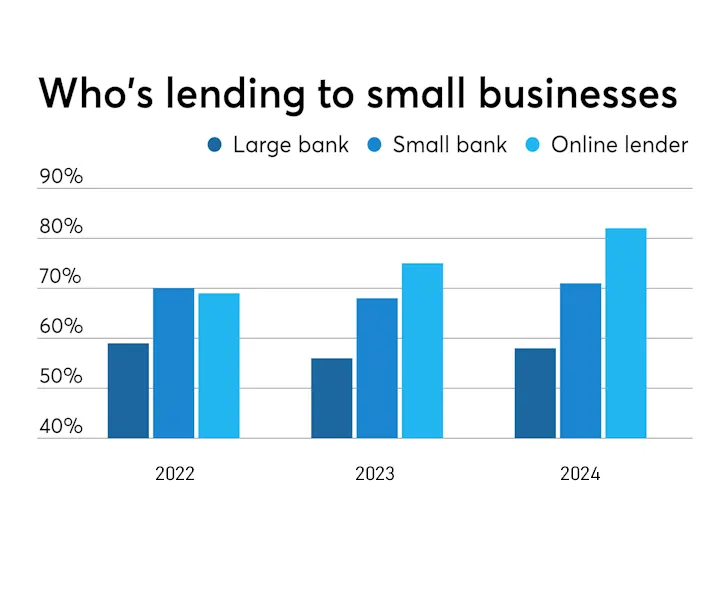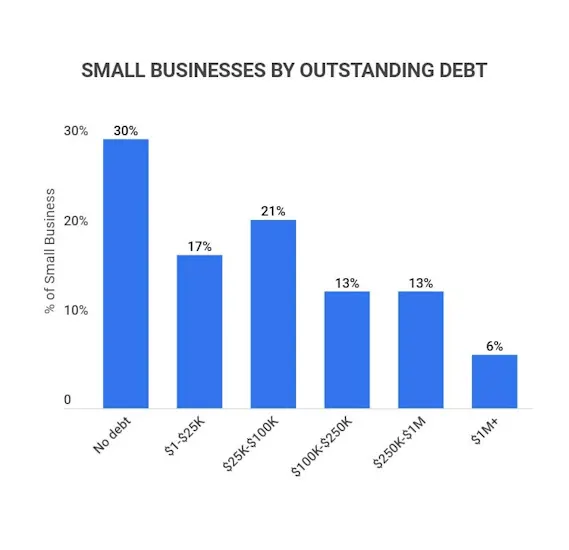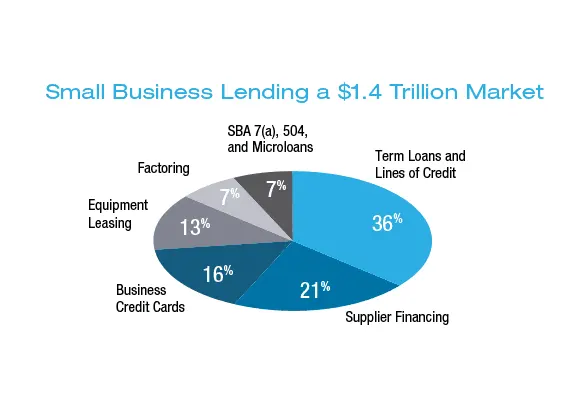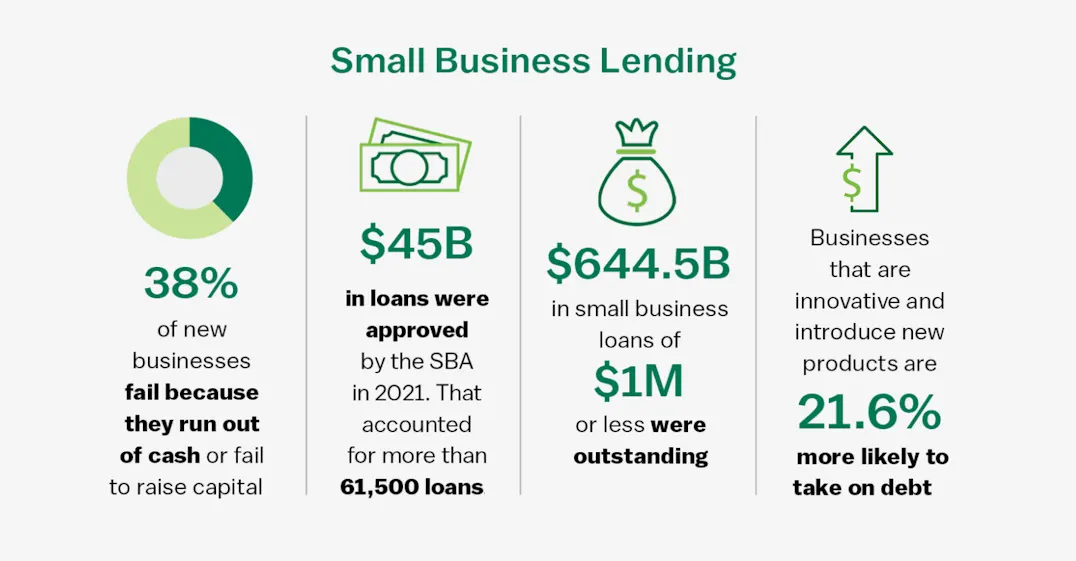December 1st, 2025
Small business lending (SBL) plays an important role in funding productive investment and fostering local economic growth.
Recently, nonbank lenders have gained market share in the SBL market in the United States, especially relative to community banks.
Among nonbanks, Fintech lenders have become particularly active, leveraging alternative data for their own internal credit scoring. We use proprietary loan-level data from two Fintech SBL platforms (Funding Circle and LendingClub) to explore the characteristics of loans originated pre-pandemic (2016‒2019).
Results show that Fintech SBL platforms lent more in zip codes with higher unemployment rates and
higher business bankruptcy filings.
Also, Fintech platforms’ internal credit scores were able to predict future loan performance more accurately than the traditional approach to credit scoring, particularly in areas with high unemployment.
Comparing Fintech SBL with traditional bank business cards in terms of credit access and interest rates, shows that overall Fintech lenders have a potential to create a more inclusive financial system, allowing small businesses that were less likely to receive credit through traditional lenders to access credit and to do so at lower cost.
The changing landscape of Small Business Lending (SBL) in the U.S.
The changing landscape of Small Business Lending (SBL) in the U.S., particularly focusing on the roles of large banks versus nonbank (or “shadow banking”) entities has become quite an important transformation since early 2025.
Here’s a breakdown of the key points that need to be considered by Small Business Owners:
- Increased SBL Activity by Large Banks: Large U.S. banks have been doing more small business lending lately compared to the overall banking industry. However, this increase is relative to the broader industry and not necessarily an absolute increase.
- Shift to Nonbank Lenders: Over recent years, the majority of new small business loans have been coming from nonbank lenders rather than traditional banks. This shift is significant and indicates a change in the sources of small business financing.
- Regulatory Burdens on Banks: The increase in regulatory requirements since the 2008 financial crisis (e.g., the Dodd-Frank Act of 2010) has made it more expensive and complex for banks to issue small loans. Compliance costs and stricter regulations make it harder for banks to profitably lend to small businesses.
- Nonbank Lenders’ Advantages: Nonbank lenders are not subject to the same strict regulatory oversight and supervisory examinations that banks face. This lighter regulatory touch allows them to operate more flexibly and often more cost-effectively, making them more competitive in the small business lending market.
- Technological Advances and Post-Crisis Pressures: Advances in technology and pressures on bank profitability post-crisis have also contributed to the shift. Technology has enabled nonbank lenders to streamline processes and offer loans more efficiently, while banks have faced pressures to adapt their business models in response to changing economic conditions.
Generally, while large banks have increased their small business lending, nonbank lenders have become the dominant players in this space due to fewer regulatory constraints and technological innovations.

Small Business Lending and Large Lending Institutions and Banks
Small businesses often face significant hurdles when seeking loans from banks and larger lending institutions, primarily due to stringent qualification criteria and rigorous approval processes.
These traditional lenders typically require high credit scores, substantial financial documentation, and collateral, which can be challenging for smaller or newer businesses to provide.
The lengthy approval times and inflexible loan terms further exacerbate the difficulty, making it hard for small businesses to secure timely funding needed for growth or day-to-day operations.
As we have all experienced, the impersonal nature of large institutions can result in a lack of personalized support, leaving small business owners to navigate complex financial products and potentially unfavorable terms on their own.

Small Business Lending and Fintech
Small businesses today grapple with several difficulties in the current lending landscape, even with the advent of Fintech.
Despite promises of faster and more accessible capital, these businesses often face stringent requirements, high-interest rates, and complex fee structures that obscure the true cost of borrowing.
Additionally, many small businesses struggle with the lack of personal service and relationship-building found in traditional lending, compounded by concerns over data privacy and security with new Fintech platforms.
Navigating these challenges can be daunting, particularly as regulatory standards and market saturation add further layers of complexity to securing the necessary funding for growth and stability.

The growing role of Fintech lenders in the small business lending (SBL) sector and their advantages over traditional banks
Here’s a breakdown of the key points:
- Rise of Fintech Lenders: Fintech companies like Funding Circle and LendingClub are becoming significant players in the nonbank SBL sector. These companies use advanced technologies such as big data and artificial intelligence/machine learning (AI/ML) to assess credit risk and make lending decisions.
- Speed and Efficiency: Fintech lenders can make lending decisions much faster than traditional banks. Research, such as the work by Hughes, Jagtiani, and Moon (2022), shows that fintech companies like LendingClub are more efficient in processing consumer loans compared to traditional lenders of similar size.
- Advanced Data Utilization: Fintech lenders have a key advantage due to their ability to collect and analyze a wide range of nontraditional data. This includes “soft information” or qualitative data that traditional banks might not use. By leveraging this data, fintech platforms can gain a more comprehensive understanding of borrowers’ financial situations.
- Improved Credit Access: The enhanced efficiency and data capabilities of fintech lenders can lead to better access to credit for borrowers. Research by Jagtiani and Lemieux (2018, 2019) indicates that fintech lenders can provide credit to consumers who might otherwise be excluded by traditional lenders, and often at a lower cost.
In essence, fintech lenders are transforming the lending landscape by using modern technology and data analysis to streamline the process, making it faster and more inclusive compared to traditional banking methods.
How fintech lenders are making strides in the small business lending (SBL) market in the U.S. and the implications of their growing role.
Here’s a detailed breakdown of the key points:
- Competition with Community Banks: Fintech lenders have been able to compete effectively with community banks. This is noteworthy because community banks traditionally serve as a key source of small business loans in their local areas.
- Filling the SBL Credit Gap: Fintech lenders have stepped in to address the credit gap left by traditional banks, which have pulled back from certain segments of the SBL market. This gap often exists in underserved communities where traditional banks have reduced their market presence.
- Access to Proprietary Data: Fintech lenders often have access to unique and extensive data from payment platforms. This data provides a comprehensive view of a business, including its industry and location, which can enhance the accuracy of credit assessments. For instance, large tech companies like Amazon and fintech firms like Square and PayPal gather detailed transaction data through their payment systems. They use this data to assess the creditworthiness of businesses with limited credit histories but robust cash flows and transaction records.
- Use of Alternative Data: Besides proprietary payment data, fintech lenders also utilize alternative data sources to make lending decisions. Companies such as Kabbage, OnDeck, Funding Circle, and LendingClub incorporate various nontraditional data points into their credit assessments. This alternative data can include transaction histories, social media activity, or other business performance indicators.
- Efficiency and Cost Reduction: Fintech lenders have managed to reduce the costs associated with originating small loans. By digitizing the application and decision-making processes, they have made the fixed costs of issuing small, short-term loans relatively minimal compared to traditional banks. This digitization helps make lending to small businesses more cost-effective.
- Concerns and Risks: Despite the advantages, there are concerns about the potential risks associated with fintech lending. The validity of fintech credit scoring methods in various economic conditions, such as during a severe recession, is uncertain. If these scoring techniques are not reliable under different economic circumstances, it could have negative consequences for borrowers and overall financial stability.
Fintech lenders are making significant inroads in the small business lending market by leveraging advanced data and technology.
They are filling gaps left by traditional banks and improving efficiency. However, there are concerns about the long-term reliability of fintech credit scoring methods and their potential impact during economic downturns.
Fintech lenders have successfully broadened credit access for small business owners who might struggle to secure funding from traditional banks. This is especially pertinent for those with limited credit histories or those operating in regions with high local unemployment rates and elevated business bankruptcy rates. For instance, Funding Circle has provided loans to many small businesses that would have been denied by banks due to the owners’ FICO scores. Additionally, Funding Circle has been more active in lending to areas with higher unemployment and bankruptcy rates, even after accounting for other risk factors.
How fintech lenders navigate state-specific regulations on interest rates and how this affects the geographical distribution of their loans.
Here’s a detailed explanation:
- Geographical Distribution of Fintech Loans: The analysis focuses on how fintech loans are distributed across different states, relative to the total amount of personal loans issued by fintech companies.
- State Usury Laws: Usury laws are regulations that limit the maximum interest rate that can be charged on loans. Different states have varying ceilings for these rates.
- Partnerships with Specialist Banks: Fintech lenders often partner with banks that are specialized in handling regulatory aspects. By working with these banks, fintech lenders can effectively sidestep state-specific usury laws that would otherwise restrict the interest rates they could charge.
- Circumvention of Interest Rate Ceilings: Because of these partnerships, fintech lenders can offer loans with interest rates that might exceed state-imposed ceilings without directly violating the law. The specialist banks, which are more familiar with regulatory nuances, help fintech lenders comply with state laws while still making competitive loan offers.
- Consistency Across States: As a result of these partnerships, the distribution of fintech loans remains relatively consistent across states, regardless of the differences in each state’s maximum allowable interest rates. This means that fintech lenders are able to offer similar amounts of loans in states with high or low interest rate ceilings, because their operational model is designed to work around these state-specific restrictions.
Fintech lenders’ partnerships with specialist banks allow them to navigate around state usury laws, leading to a more uniform distribution of fintech loans across different states.
This happens because these partnerships help fintech lenders avoid the constraints imposed by varying state interest rate ceilings.
--- article sharing ---
